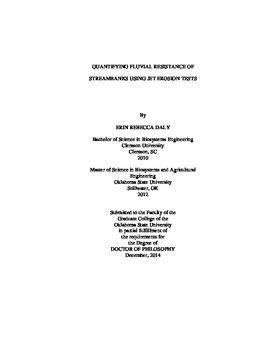| dc.contributor.advisor | Fox, Garey | |
| dc.contributor.author | Daly, Erin Rebecca | |
| dc.date.accessioned | 2016-01-20T15:44:30Z | |
| dc.date.available | 2016-01-20T15:44:30Z | |
| dc.date.issued | 2014-12 | |
| dc.identifier.uri | https://hdl.handle.net/11244/25645 | |
| dc.description.abstract | The United States has over forty-thousand impaired water bodies with sediment listed as one of the top five causes of impairment. Recent research has found that more than 50% of fine sediment in watersheds originates from channel sources. This highlights the need for watershed management strategies geared towards channel erosion, specifically in the form of streambank erosion. Process-based models are often used to study streambank erosion mechanisms and predict erosion in order to work towards more comprehensive watershed management solutions. The fluvial erosion component of these models is based on the excess shear stress equation dependent on the erodibility parameters - the critical shear stress (tauc) and the erodibility coefficient (kd). One of the most commonly used methods of measuring the erodibility parameters is the Jet Erosion Test (JET). However, there has been discussion recently regarding the derivation of the erodibility parameters from JET data, the variability of results, and the effects of subaerial processes on parameter estimation. There remains a large gap in the knowledge with regard to these points. In order to begin addressing some of these gaps, the overall objectives of this research were (1) to evaluate new solution methodologies for the derivation of the erodibility parameters, tauc and kd, from the JET, (2) investigate the erodibility parameters using all three techniques by considering parameter uniformity, correlations between the derived parameters and physical soil properties, and the applicability of currently proposed relationships to estimate the erodibility parameters at both a site and watershed scale, and (3) to apply the results from JET data to composite streambanks within a process-based modeling framework. The new solution methodologies, the scour depth and iterative solutions, were found to provide improved fits over the Blaisdell solution and incorporated into an automated spreadsheet. The erodibililty parameters were explored at both a site and watershed scale and found to vary spatially and temporally by orders of magnitude. This large amount of variation, coupled with the new solution techniques, have shown currently used empirical relationships to estimate the erodibility parameters to be generally invalid for the systems included in this study. This research highlights the need to measure the erodibility parameters in situ and the continued research into parameter variability and the role of subaerial processes in cohesive streambank erosion. | |
| dc.format | application/pdf | |
| dc.language | en_US | |
| dc.rights | Copyright is held by the author who has granted the Oklahoma State University Library the non-exclusive right to share this material in its institutional repository. Contact Digital Library Services at lib-dls@okstate.edu or 405-744-9161 for the permission policy on the use, reproduction or distribution of this material. | |
| dc.title | Quantifying fluvial resistance of streambanks using jet erosion tests | |
| dc.contributor.committeeMember | Storm, Daniel | |
| dc.contributor.committeeMember | Hunt, Sherry | |
| dc.contributor.committeeMember | Bulut, Rifat | |
| osu.filename | Daly_okstate_0664D_13731.pdf | |
| osu.accesstype | Open Access | |
| dc.type.genre | Dissertation | |
| dc.type.material | Text | |
| thesis.degree.discipline | Biosystems and Agricultural Engineering | |
| thesis.degree.grantor | Oklahoma State University | |
